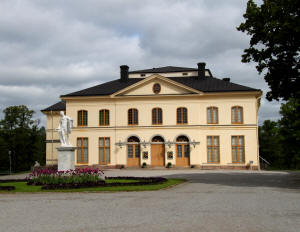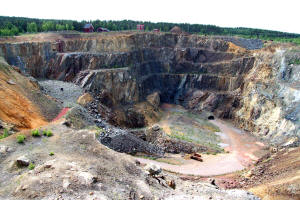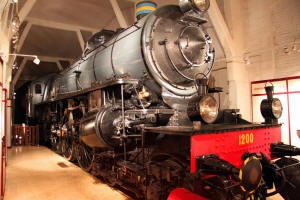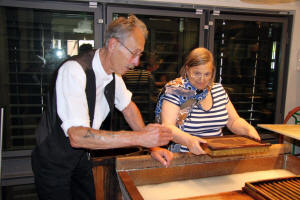AIA Spring Tour - Sweden 2011
| This was a truly remarkable trip. It included three UNESCO World Heritage Sites. Two hard-rock mines both with histories of several centuries; two ‘Lancashire’ hearths - which were the basis of Sweden’s leading position as a supplier of quality steels; and a completely preserved Baroque theatre! All this was within 200km of Stockholm, west and north. The tour was sensibly planned to avoid long coach journeys | |
| At the Drottningholm Royal Summer Palace, a short train and bus journey from Stockholm there is a perfectly preserved baroque theatre. Built in 1766, it had Summer use for less than thirty years and, with a change of king and his tastes it was then used as a furniture store until its ‘rediscovery’ in the 1920s. It was then carefully restored with the Royal Box replaced by special central seats and a specially designed electrical lighting system replacing the original candles. All the original stage machinery, man-powered by windlasses and capstan, was still in working order (except rats had eaten the ropes). The theatre is still used for the Summer season of productions of baroque operas, all in period style. Originally the stagehands were seamen used to such machinery; now they are professionals from the main Stockholm theatres doing a ‘Summer job’. Scene changes of flats and drops can be completed in 4 seconds! We had a good look at all the machinery and heard the ‘thunder- box’ thundering. It was our first World Heritage Site. |
 |
| Mining for copper and gold at Falun (Kopparberget or copper mountain) was continuous from the 10th to the 20th centuries. It was hard rock underground mining with vertical shafts and horizontal galleries. All were cut by hand with fire-setting, and later gunpowder and dynamite used to weaken the rock. On Midsummer’s Day 1687 there was there was a huge cave-in and the mine became a big pit - rather than a mountain. Fortunately it was a holiday with no men in the mine. It is still an impressive site which in the 17th century produced the greater part of the copper used in Europe. It, and the associated township of Falun is a World Heritage Site, our second. |
 |
| The silver mine at Sala was owned by the crown to monopolise its silver for coinage; it actually produced about 50 tons of lead for every ton of silver. This was another hard rock mine with its own town site. Because of the value of the ore fire-setting was preferred to explosives. Apparently some 2 to 3 cubic metres of wood was required to loosen about a fifth of a cubic metre of rock! These hard-rock mines drew on large surrounding areas for their huge timber needs. Also, as they used water power to drive their hoists and pumps, they also had elaborate canal and dam systems which had to work year round. The Sala mine went down to a depth of 300m, Falun was less deep. Roasting, the first stage of extraction from the ore, was done locally and needed even more wood for fuel. |
Carl XI shaft, Sala, image by Riggwelter. No snow when we saw it! |
| The ‘Lancashire Hearth’ was a Swedish development of a method for producing wrought iron/steel from pig iron, akin to puddling. At Engelsberg Bruk there is a well preserved blast furnace which operated from 1779 to 1919 – producing all of 10 tonnes a day. The blowers and hoists were driven by water wheels. Just up river was a ‘Lancashire Hearth’ forge with two hearths and a trip hammer, again with its own water wheel. Quite a number of the buildings of the ‘bruk’ or village are preserved and the whole complex is a World Heritage Site. |
|
|
We saw another ‘Lancashire Hearth’ forge plant at Trangfors near the Stromsholm Canal. This had four ‘Lancashire Hearths’ and a water-powered trip hammer.
Its restoration, since 1988, has been entirely by volunteer activity. We were very impressed by the work that had been done.
The Stromsholm canal was built in 1772-95 for the export of iron bars. It is 12km long between navigable lakes. Much of the excavation was in solid rock. It was superseded by the railway, with the last cargo vessel in 1948. The fall at the Hallstammer locks is 50 metres. |
|
|
Lake Amanningen is another part of the Stromsholm Canal system and on it is ‘oil island’ which is home to the oldest oil refinery in the world, not a World Heritage Site!
It operated as a distillery from the mid 1870s to 1902, and continued blending lubricating oil and greases until 1921. We were guided through it in very lucid English by the 93 year old son of the last owner. It was a remarkable visit in many ways. |
|
| In Eskilstuna, the Sheffield of Sweden, we saw the Rademacher forges. These were built in the mid 1600’s with the idea of attracting skilled men to Sweden to increase manufacturing capacity, especially of firearms. Twenty of the old buildings are now occupied by craft workers, a blacksmith, a goldsmith and a coppersmith and one knife maker/cutler. He showed figures for the history of cutlers in Eskiltuna – 2 in the late 1700s, up to 180 in the 1800s and now back to 2 again, he being one of them; much like Sheffield! Eskilstuna had a good industrial/technical museum with a fine show of machine tools by Munktells, the local maker. There was a display of stationary steam engines and a British locomotive; much to our delight. |
Sharp Stewart & Co, Atlas Works, Manchester, No 2428, 1874 |
|
The Swedish Railway Museum in Gavle was another point on the tour. The main museum is in a converted roundhouse. Exhibits were well presented and labelled.
The Beyer Peacock locos from Manchester in 1856 had been the first in Sweden. A hundred years later Sweden was exporting locos, steam and then electric, ASEA of course.
There was the usual display of Pullman cars, with second and third class as well. A preserved linesman’s cottage gave an opportunity to learn a little about the linesman’s duties. He was expected to walk the track before each train. This included clearing snow. His plough was for only one rail which he would push for maybe 2km before turning on to the other rail to push ‘home’! He had a day off every other Sunday, but had to cover for his neighbour on the other Sunday. The cottage had some land and outbuildings attached so that he could keep some livestock and grow some produce, for ‘own consumption’ only. |
 |
|
Our final visit was to the site at Tumba where the special paper for banknotes has been produced since 1758. Some of the original buildings have been refurbished
to form a delightful museum. The needs of security required the plant to be in an isolated location. The workers lived on site and plant which formed its own community with school, hall, library, musical bands and sports activities. Next door is the present producer of banknote paper, well secured but not so isolated. |
 Sue Hayton gets a lesson in papermaking |
|
For some of the party a very special ‘extra’ was a visit to the Vasa museum in Stockholm. The ship is in a remarkable state of preservation and the collection of
items from her is very extensive. All is beautifully presented together with background displays on 17th century shipbuilding and fitting-out. It is an outstanding museum.
Words Copyright © Richard Hartree 2011 Images Copyright © Bill Barksfield 2011 (except as indicated) |
|
